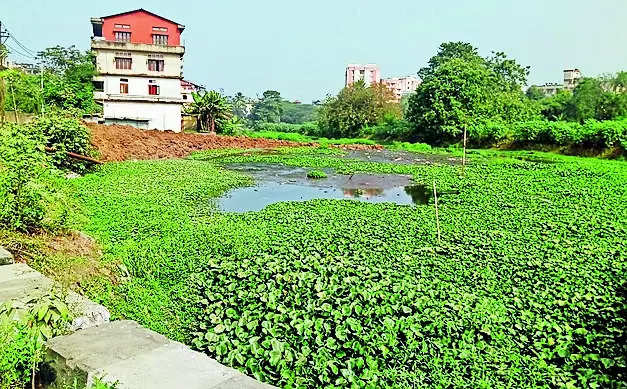Guwahati: A 9-km-long sewage drain that releases waste water, outlets of septic tanks, garbage dumping and unabated encroachment over the decades are the key factors behind the choking of the Borsola Beel that works as a rainwater reservoir during the monsoon and plays a key role in sustaining the ecology.
Conservationist Hemen Lahkar, who is also the president of Greater Chatribari Development Committee, said the beel is choking and has lost the capacity to absorb rainwater during monsoon.“Despite repeated pleas to protect and preserve it, government has done precious little for which a vast area of the city turns into a basin after every spell of rain,” he added.
Lahkar said the drain leading from Noonmati to Solabeel carries sewage, waste water and garbage of almost the entire east Guwahati to the Borsola Beel. “The outlets and small drains are connected to the drain in the entire stretch. This has posed a threat to the ecology of the beel. Already, there are no fish or other aquatic life in the wetland,” he added.
Lahkar said the wetland is dying despite the existence of the Guwahati Water Bodies (Preservation and Conservation) Act, 2008, and the Gauhati High Court’s 2000 directive that wetlands should be properly preserved and kept free of pollution.
“Even various important buildings, including a few government ones, have been constructed illegally on the land of the beel after the Guwahati Water Bodies (Preservation and Conservation) Act came into existence in 2008. Now, Guwahati Municipal Development Authority wants to construct a water treatment plant by filling up a portion of the beel with soil,” he added.
He questioned the government if it can revive the Silsako Beel then where is the problem in reviving and preserving the Borsola Beel.
“There were around 300 wetlands in Guwahati during the British era. But now, there are only six or seven. That is the reason why floods in Guwahati have worsened over the decades,” he added.
It is pertinent to mention that the development of the beel was the first project of the Guwahati Smart City Limited established in 2016. A total of Rs 80 crore was allotted for the development of the wetland. However, no steps were taken and then the project was abandoned for unknown reasons.
We also published the following articles recently
Conservationist Hemen Lahkar, who is also the president of Greater Chatribari Development Committee, said the beel is choking and has lost the capacity to absorb rainwater during monsoon.“Despite repeated pleas to protect and preserve it, government has done precious little for which a vast area of the city turns into a basin after every spell of rain,” he added.
Lahkar said the drain leading from Noonmati to Solabeel carries sewage, waste water and garbage of almost the entire east Guwahati to the Borsola Beel. “The outlets and small drains are connected to the drain in the entire stretch. This has posed a threat to the ecology of the beel. Already, there are no fish or other aquatic life in the wetland,” he added.
Lahkar said the wetland is dying despite the existence of the Guwahati Water Bodies (Preservation and Conservation) Act, 2008, and the Gauhati High Court’s 2000 directive that wetlands should be properly preserved and kept free of pollution.
“Even various important buildings, including a few government ones, have been constructed illegally on the land of the beel after the Guwahati Water Bodies (Preservation and Conservation) Act came into existence in 2008. Now, Guwahati Municipal Development Authority wants to construct a water treatment plant by filling up a portion of the beel with soil,” he added.
He questioned the government if it can revive the Silsako Beel then where is the problem in reviving and preserving the Borsola Beel.
“There were around 300 wetlands in Guwahati during the British era. But now, there are only six or seven. That is the reason why floods in Guwahati have worsened over the decades,” he added.
It is pertinent to mention that the development of the beel was the first project of the Guwahati Smart City Limited established in 2016. A total of Rs 80 crore was allotted for the development of the wetland. However, no steps were taken and then the project was abandoned for unknown reasons.
We also published the following articles recently
Protests over plan to set up water plant on Borsola Beel
Conservationists and public committees oppose Guwahati Metropolitan Development Authority’s plan to build a water treatment plant by filling up part of Borsola Beel wetland with soil. The wetland plays a crucial role in managing rainwater during the monsoon. Encroachment and pollution have caused the wetland to shrink and lose its capacity.
Conservationists and public committees oppose Guwahati Metropolitan Development Authority’s plan to build a water treatment plant by filling up part of Borsola Beel wetland with soil. The wetland plays a crucial role in managing rainwater during the monsoon. Encroachment and pollution have caused the wetland to shrink and lose its capacity.
Wanted Maoist leader arrested in Guwahati
The Special Task Force (STF) of Assam Police apprehended a senior functionary of the banned CPI (Maoist), who was declared “most wanted” by the National Investigation Agency (NIA) in 2022.
The Special Task Force (STF) of Assam Police apprehended a senior functionary of the banned CPI (Maoist), who was declared “most wanted” by the National Investigation Agency (NIA) in 2022.
Guwahati Jal Board bags award for e-governance, IT initiative
The Guwahati Metropolitan Drinking Water and Sewerage Board (Guwahati Jal Board) received the prestigious Awarding Innovation by the Center for Innovation in Public Systems award of the Administrative Staff College of India of Hyderabad at an event in Shillong on Friday.
The Guwahati Metropolitan Drinking Water and Sewerage Board (Guwahati Jal Board) received the prestigious Awarding Innovation by the Center for Innovation in Public Systems award of the Administrative Staff College of India of Hyderabad at an event in Shillong on Friday.
